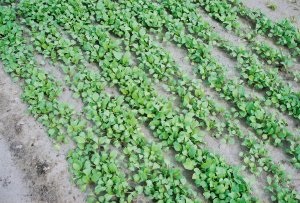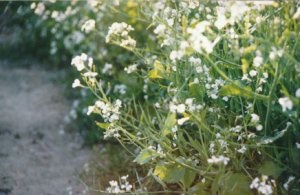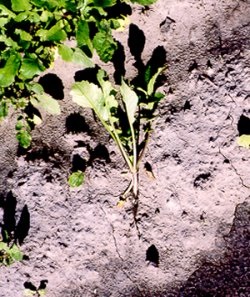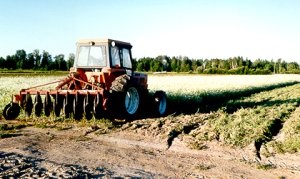Cover crops: oilseed radish
Information on the benefits and growth habits of oilseed radish planted as a cover crop.
Description
Family
- Brassicae.
- Non-legume broadleaf.
Growth habits
Top growth
- Seedling develops as rossette, then elongates with the flower stalk.
- Grows to a height of 50 to 100 cm.
- Top growth is rapid and cover is complete.
Overwintering
- Unaffected by early frost.
- Resistant to mild freezing, - 4°C kills seedlings.
- Will winterkill – in normal winter conditions.
Site suitability
- Prefers cool, moist growing conditions
- Soil types - well drained loams to clay loams
- Intolerant of shade or traffic
Control options
- Tillage, freezing and common burndown herbicides will usually control oilseed radish.
Sensitivity to herbicides
- Many of the Group 2 herbicides, and the triazine herbicides, can have soil residuals that may injure oilseed radish seedlings.
- Consult the product labels or Publication 75, Guide to Weed Control for information on how these herbicides may affect canola, cabbage or other members of the mustard (cruciferae) family of plants.
Weed control
- One method of controlling volunteer cereals and other annual weeds is to disc or cultivate immediately after harvest and then till the soil again just before seeding the cover crop (stale seedbed).
- Care should be taken not to delay the date of seeding, since a vigorous and competitive cover crop is your best weed control.
- There are no herbicides registered for use on oilseed radish crops. Care should be taken that the oilseed radish crop is not allowed to establish viable seed, unless it is to be harvested for seed production, to reduce problems with volunteer oilseed radish in the next crop.
- There is a certain percentage of hard seed that may not germinate in the year of planting and may pose a weed problem in later years.
- Oilseed radish can bolt and flower by October. If viable seed is set, this too could become a weed problem.
Benefits and concerns
Nutrient management
- Good nitrogen scavenger — is a good fit with fall manure applications or when excess soil nitrogen is expected
- Oilseed radish can take up a lot of excess nitrogen, but because it winterkills early in the winter, the nitrogen will be released early in the spring as the ground warms. It has been referred to as a "leaky" cover crop.
Pest management
- Some varieties such as Adagio and Kernel have nematode suppressing abilities due to high active glucosinolate levels. Nematicidial activity depends on which glucosinolates are present, in what amount in the plant and which nematodes the compound is active on.
- Nematode suppression is not consistent across varieties. Nematode suppression relies upon turning under large amounts of green matter with high glucosinolate levels. The sulphur containing compounds in the crop residues break down into chemicals very similar to commercial fumigants. The glucosinolate levels vary greatly among varieties.
- Clubroot disease and cabbage root maggot can affect many of these types of cover crop. Avoid using these cover crops in a rotation that includes brassicas in the main crop.
Organic matter
- Residues have low lignin content resulting in rapid decomposition.
- Returns moderate amounts of organic matter to the soil.
- Can produce 1.5 t/A dry matter if residual nitrogen levels are high.
- Decaying residue left on the surface overwinter may have a strong smell.
Getting started
Establishment
- Seed in mid-August to early September — later seeding will not attain proper stand density and growth.
- Drill at 10 to 12 lbs/acre or broadcast at 12 to 15 lbs/acre.
Cost and availability
- Moderate cost depending upon the variety. Nematode suppressing varieties are usually more expensive.
Updated: January 15, 2025
Published: August 24, 2022



